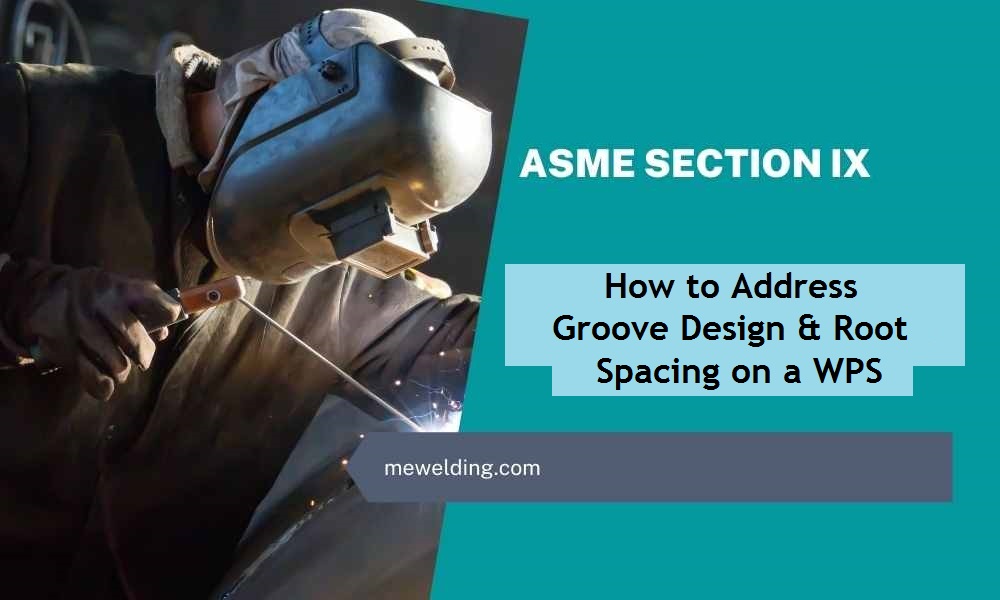This article discusses about the subject of root spacing and groove design. How to address these variables on a WPS made in accordance with ASME Section IX?

Let’s begin right away.
Groove Design
Groove design is a non-essential variable for most processes, except EBW. So a change from one groove type to another does not require requalification. However, it must be addressed on the WPS. How to specify it – is up to the welding engineer. There can be several ways of addressing this variable.
Sometimes I am tempted to write ‘any’, or ‘all’, or to address this variable on the WPS. The thinking behind this goes that since this is a non-essential variable, a change from any groove design to any other groove design does not require requalification anyway. So, what’s wrong with writing ‘all’ or ‘any’ while addressing this variable?
Would I be right if I did this? Would it violate Section IX if I did this? What is Section IX’s intent behind this?
Before I answer, consider this interesting question that was asked in Interpretation IX-82-02. The question is as follows:
“QW-402.1 states, “A change in the type of groove (Vee-groove, U-groove, single-bevel, double-bevel, etc.).” This variable is a nonessential variable for SMAW, GTAW, GMAW, and FCAW. Currently, a Manufacturer states, “All groove designs” under joint design in the WPS. Is this practice acceptable, or is it required to either include these in the WPS or reference another document that illustrates all possible joint configurations?”
The reply given by the Committee goes like this: “The practice of stating “all groove designs” on the WPS to satisfy QW-402.1 is not acceptable. Because the WPS is for the guidance of the welder or welding operator, a Manufacturer must state on the WPS the types of joints permitted in production. Alternatively, a reference to a drawing or other document that describes the allowable production joints is permitted.”
This answers the questions that I asked above. So now that we know that ‘all’ or ‘any’ is not an appropriate answer, what is the right way to address this variable on the WPS?
How to Rightly Address Groove Design on a WPS
It is a good practice to specify the particular type of groove that the welder is going to encounter on the job. More than one type of groove designs (such as V-groove, U-groove, J-groove, etc.) can be specified.
If the same WPS is going to be used for welding same kind of joints again and again, it is good to specify other details such as included angle of the groove, root face (or land), part description, etc. as well. All these details can be illustrated through a sketch. The sketch can be drawn in the space provided for it in the format (QW-482) or by attaching a separate sheet containing the diagram.
Another way that is equally acceptable is by referring to a manufacturing drawing. This in fact is a better way of addressing this variable. The sketch made on the WPS format can only convey that much details. The manufacturing drawing on the other hand, can convey far greater number of helpful details. This gives the welder a more complete picture about the weld joint.
However, the welding engineer must keep in mind that the manufacturing drawing must have shown some kind of groove. Only then the variable would be considered addressed.
Another thing that the engineer should make sure is that the welder should have access to the drawing referred in his WPS. Otherwise there is no point.
Root Spacing on a WPS
The discussion above applies to root spacing (also called root gap in some places) too. It is not an essential variable for any of the processes under QW-250. For some of the processes, it is a non-essential variable.
This means that a PQR qualified with a particular root spacing in the test coupon can be used to support production joints having any other root gap.
Put another way, this means that root gap can be increased by an unlimited amount in the production weld, without worrying about what was followed in the procedure qualification. This finds the Section IX’s committee’s further approval in an Interpretation IX-89-42.
However, since it is a non-essential variable, it must be addressed on the WPS.
If a WPS showing a certain root spacing needs to be used on a joint with some other root spacing, the original WPS needs to be revised to show the correct root spacing (this formed the subject of an Interpretation IX-83-71). Doing so will not require requalification of the procedure.
How to Address Root Spacing on a WPS
It is not a correct way to address this variable by writing words such as ‘any’, ‘all’, etc. Because such words do not serve to guide the welder in any manner, which is the principal purpose of the WPS.
If a WPS is used for a large number of joints, a range can be written for the root spacing (the Committee’s approval for this is reflected in the Interpretation IX-83-04 (qs 2)). If the WPS is going to be used for same joints again and again, it is good to indicate the exact root spacing on the WPS. Alternatively, this variable can also be addressed by referring to a manufacturing drawing.
However, the welding engineer should ensure that root spacing is indicated on the referred drawing, and the drawing is accessible to the welder.
The welding engineer may decide suitably on how he wants to address it. Basically, the idea is to provide direction to the welder.
Trivia
Section IX has used the term ‘fit-up gap’ a few places. The terms ‘fit-up gap’ and ‘root-gap’ mean the same thing. This finds a mention in the Interpretation IX-83-04 (qs 1).
So, this was all I have right now to offer on this subject. Please share your thoughts in the comments section below.
